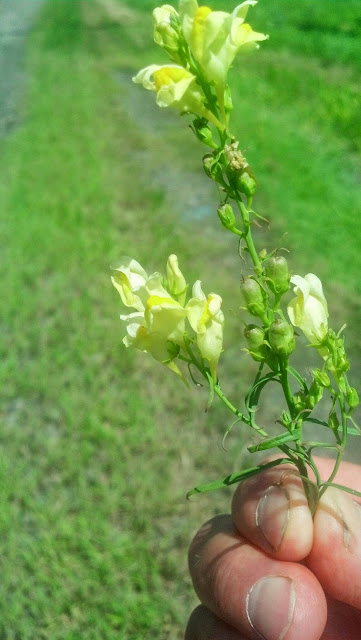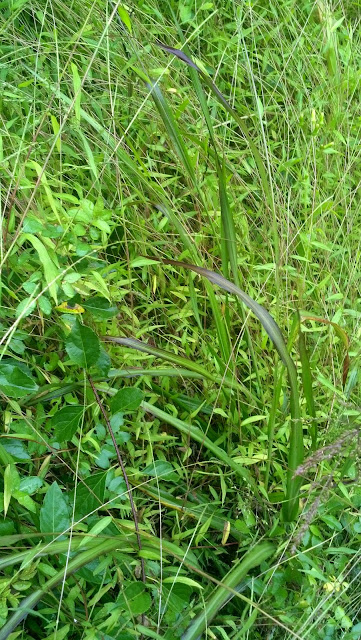True bug of some kind.
Sunday, September 28, 2014
Wednesday, September 24, 2014
Saturday, September 13, 2014
Wildflower Certification 4: Grasses
On September 13, 2014, the Wildflower Certification class took a trip to Coverdale Farm to learn about grasses and late-season plants. The weather was rainy.
We started out in a shelter near one of the farm fields. We looked at some ruderal species--ones that colonize disturbed habitats. These include
Crabgrass (digitaria)--an annual , non-native, invasive grass.
Goose grass (Eleusine indica)--this grass thrives in areas with heavy foot traffic. It can be seen on paths growing in a flattened clump.
---
Walking towards the meadow, we saw grasses of less disturbed habitats:
Slender muhly (muhlenbergia tenuiflora)
Broom sedge (Andropogon virginicus) despite its name, is a grass.
Beaked panic grass (Panicum anceps)
 |
| Weather: rainy
Foxtail grass processes c4 more efficiently than some other grasses, but alsoneeds warmer temperatures.
Purpletop, or grease grass, has a panicle and a white ligule,
Besides the grasses, we saw the following plants and flowers:
|
Turtlehead flowers are good for attracting the Baltimore Checkerspot butterfly.
Wild basil has a stem that goes right through the flower.
Aster
Goldenrod
Others that I got no pictures of:
panicked aster
lambs quarters
purple stemmed aster
arrow leaf tear a thumb
Saturday, August 23, 2014
Wildflower certification 3: Wetland plants
On August 23rd, 2014, the Wildflower Certification class visited three locations to learn about wetalnd plants. I was able to attend the part of the class at Dragon Run park in Delaware City. I have added some pictures of wetland plants from separate days at the Dupont Environmental Education Center, Ashland Nature Center, and Lums Pond State Park.
The Swamp Rose Mallow, Hibiscus moscheutos, is a perennial with toothed alternate leaves. The flower blooms through the summer. There is even a Rose Mallow bee that is a specialist pollinator of this flower.
Halberd-leaved tearthumb (Polygonum arifolium) is a vinelike wildflower in the smartweed family. It has alternate leaves. The barbs that give it the "tearthumb" part of its name, visible in this picture, help it climb over other plants. It make a good protective cover for wildlife.
Buttonbush (Cephalanthus occidentalis) is a shrub in the Rubaciae family. It is recognizable by its ball-like flowers. It has leaves in twos or threes.
Wool grass (Scirpus cyperinus) is actually a sedge. It is a perennial with alternate leaves that gets its name from its fluffy-looking flowers.
Orange jewelweed (Impatiens capensis) is in the Touch-me-not family. It has an irregular flower and alternate, toothed leaves.
Marsh fern (Thelypteris palustris) grows from one to two and a half feet tall. It is a twice-cut fern with alternating fronds.
Cut-leaved Grape Fern (Botrychium dissectum) grows to about a foot. The fronds in this picture have lacy edges, but that is not always the case with this plant. It is sometimes confused with the rattlesnake fern. On the left, you can see the fertile frond with grapelike sori that give the plant its name.
Cardinal flower is a perennial wetland flower with long, narrow red blooms. The shape of the flower is suited to.long beaks of hummingbirds, which are a major pollinator. The picture below shows Cardinal flower next to Rose Mallow at the Dupont Envirinmental Education Center.
And here is a closeup of a Cardinal flower from Lums Pond State Park in 2013.
 |
| Put me back! |
Wednesday, August 6, 2014
More pods
I found this in the parking lot of my apartment. I thought at first it was a green sweet gum ball, but those are spiky, whether green or brown.
Tuesday, August 5, 2014
Monday, August 4, 2014
Sunday, July 27, 2014
Differences in green; sunflowers?
The Russell Peterson Wildlife Preserve. Dark green is cattails, medium green is pickerel weed, yellow green is wild rice. Good job on the phragmites eradication, DNREC!
Friday, July 25, 2014
Recon mission
We walked out along the train tracks to see what kind of building DNREC is up to in the marsh.
 |
| Viceroy (smaller than a monarch) |
 |
| The old electric box for the train |
 |
| A closer view of the osprey nest |
 |
| Green frog at one of the frog ponds out in the marsh |
 |
| The first frog's cousin Bob |
 |
| One of the trees DNREC planted...maybe we'll be back in fifty years and see it huge! |
 |
| When the gates open again, this will all be underwater. |
 |
| Nice black gum tree...likes lots of water |
 |
| Leaves of a black locust tree |
 |
| Train going by; DEEC is tiny square in the distance. |
 |
| Butter-and-eggs, in the snapdragon family |
Subscribe to:
Posts (Atom)












































